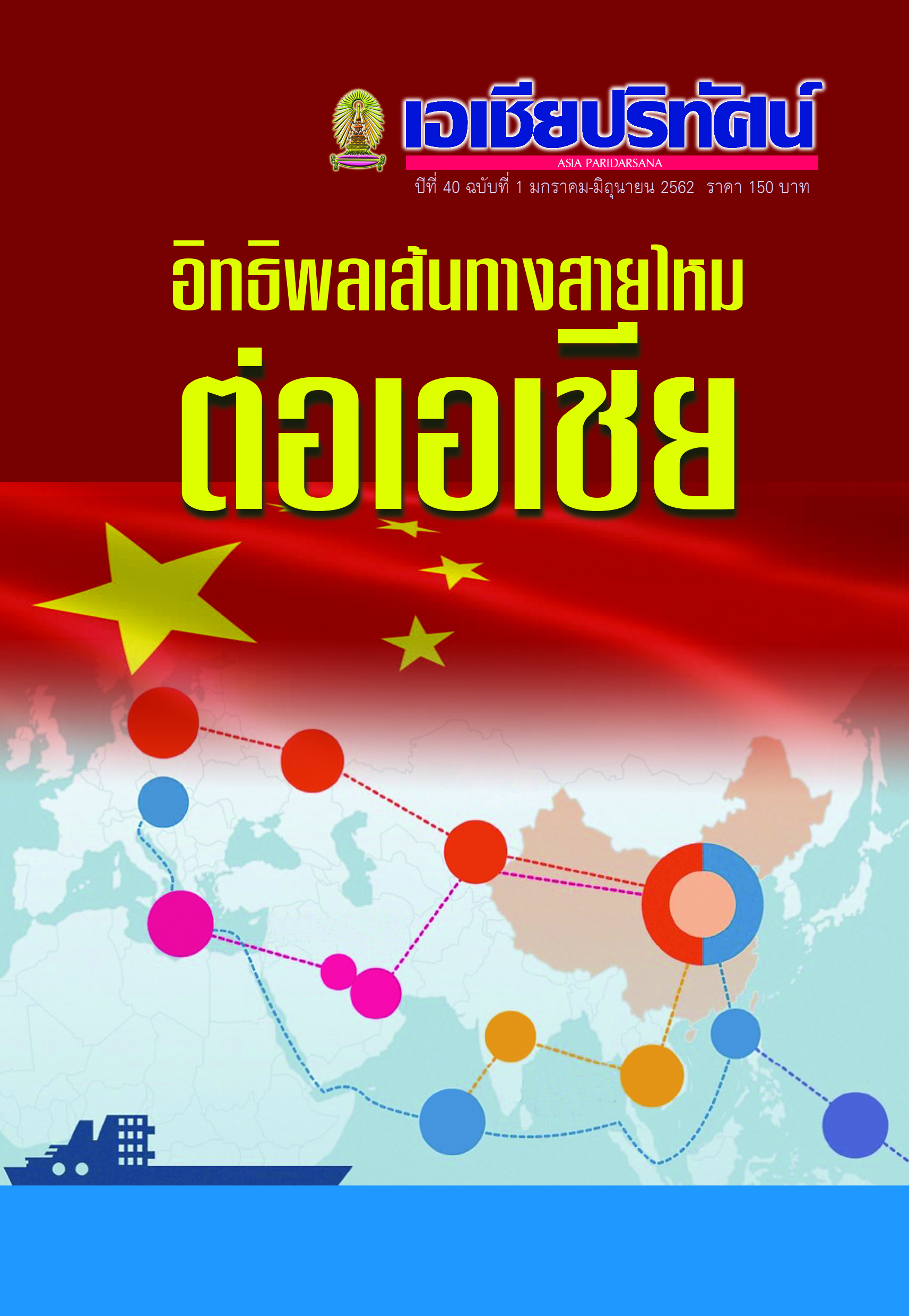ยุทธศาสตร์ One Belt One Road ของจีนในภูมิภาคตะวันออกกลาง
Main Article Content
บทคัดย่อ
เส้นทางสายไหมเคยเป็นเส้นทางเชื่อมต่อโลกตะวันออกและโลกตะวันตกมาตั้งแต่โบราณกาลกระทั่งหมดความสำคัญลงไปตามเงื่อนไขประวัติศาสตร์และกาลเวลา จีนต้องการฟื้นฟูเส้นทางสายไหมนี้ขึ้นอีกครั้งให้เป็นเส้นทางสายไหมในศตวรรษที่ 21 จึงทำให้เกิดโครงการ One Belt One Road (OBOR) ซึ่งริเริ่มโดยประธานาธิบดี สี จิ้นผิง เพื่อเชื่อมต่อจีนเข้ากับ 60 ประเทศในทวีปเอเชีย-แอฟริกา-และยุโรป ผ่านเส้นทางสายไหมทั้งทางบกและทางทะเลดังเช่นในอดีต ด้วยยุทธศาสตร์นี้ภูมิภาคตะวันออกกลางจะมีบทบาทสำคัญในฐานะที่เป็นจุดเชื่อมของสามทวีปทั้งเส้นทางสายไหม ทางบกและทางทะเล ทำให้จีนจำเป็นต้องดำเนินนโยบายเชิงรุกเพื่อแสวงหาและรักษาผลประโยชน์ของตนในภูมิภาคตะวันออกกลางในระยะหลัง ทั้งการแสดงบทบาททางการทูตผ่านความขัดแย้งในซีเรีย สร้างฐานทัพนอกประเทศครั้งแรกที่ประเทศจิบูติ และตีพิมพ์เอกสารนโยบายจีนต่อประเทศอาหรับ นอกเหนือจากผลประโยชน์ทางเศรษฐกิจซึ่งมีพลังงาน การค้าและการลงทุนเป็นเรื่องหลักแล้ว จีนยังหวังว่าการแสวงหาพันธมิตรในภูมิภาคตะวันออกกลางจะสามารถหยุดยั้งการเผยแพร่แนวคิดก่อการร้ายจากภูมิภาคดังกล่าวเข้าสู่ประเทศจีนได้ จะเห็นได้ว่าจีนกำลังเข้ามาแสดงบทบาทของมหาอำนาจใหม่ที่ท้าทายมหาอำนาจเดิม ตะวันออกกลางจึงเป็นพื้นที่สำคัญที่จีนจะสามารถปรับสมดุลการเมืองโลก ซึ่งจีนต้องการโลกที่มีหลายขั้วอำนาจ (multipolar) และโลกที่มีความสมานฉันท์
Article Details
เอกสารอ้างอิง
เส้นทางสายไหมเคยเป็นเส้นทางเชื่อมต่อโลกตะวันออกและโลกตะวันตกมาตั้งแต่โบราณกาลกระทั่งหมดความสำคัญลงไปตามเงื่อนไขประวัติศาสตร์และกาลเวลา จีนต้องการฟื้นฟูเส้นทางสายไหมนี้ขึ้นอีกครั้งให้เป็นเส้นทางสายไหมในศตวรรษที่ 21 จึงทำให้เกิดโครงการ One Belt One Road (OBOR) ซึ่งริเริ่มโดยประธานาธิบดี สี จิ้นผิง เพื่อเชื่อมต่อจีนเข้ากับ 60 ประเทศในทวีปเอเชีย-แอฟริกา-และยุโรป ผ่านเส้นทางสายไหมทั้งทางบกและทางทะเลดังเช่นในอดีต ด้วยยุทธศาสตร์นี้ภูมิภาคตะวันออกกลางจะมีบทบาทสำคัญในฐานะที่เป็นจุดเชื่อมของสามทวีปทั้งเส้นทางสายไหม ทางบกและทางทะเล ทำให้จีนจำเป็นต้องดำเนินนโยบายเชิงรุกเพื่อแสวงหาและรักษาผลประโยชน์ของตนในภูมิภาคตะวันออกกลางในระยะหลัง ทั้งการแสดงบทบาททางการทูตผ่านความขัดแย้งในซีเรีย สร้างฐานทัพนอกประเทศครั้งแรกที่ประเทศจิบูติ และตีพิมพ์เอกสารนโยบายจีนต่อประเทศอาหรับ นอกเหนือจากผลประโยชน์ทางเศรษฐกิจซึ่งมีพลังงาน การค้าและการลงทุนเป็นเรื่องหลักแล้ว จีนยังหวังว่าการแสวงหาพันธมิตรในภูมิภาคตะวันออกกลางจะสามารถหยุดยั้งการเผยแพร่แนวคิดก่อการร้ายจากภูมิภาคดังกล่าวเข้าสู่ประเทศจีนได้ จะเห็นได้ว่าจีนกำลังเข้ามาแสดงบทบาทของมหาอำนาจใหม่ที่ท้าทายมหาอำนาจเดิม ตะวันออกกลางจึงเป็นพื้นที่สำคัญที่จีนจะสามารถปรับสมดุลการเมืองโลก ซึ่งจีนต้องการโลกที่มีหลายขั้วอำนาจ (multipolar) และโลกที่มีความสมานฉันท์
คำสำคัญ : One belt one road, จีน, ภูมิภาค, ตะวันออกกลาง, แอฟริกาเหนือ, ภูมิรัฐศาสตร์
China’s One Belt One Road Strategy in The Middle East
The old Silk Road had linked the Eastern and the Western worlds since the ancient times until its decline and disintegration. China wants to restore the old Silk Road to serve as the new Silk Road of the 21st century; it has therefore proposed the One Belt One Road (OBOR) project. The initiative was taken by President Xi Jinping with a view to connect¬ing China with other 60 countries in Asia, Africa, and Europe through the network of newly developed land and sea route corridors. With this strat¬egy, the Middle Eastern region plays an important role as a link between the three continents through both sea and land routes. China’s proactive policies to search and maintain its interests in the Middle Eastern region are evident in its recent diplomatic role in the conflict in Syria, establish¬ment of the first overseas military base in Djibouti, and dissemination of Chinese policy documents to the Arab countries. Besides, given the economic interests which mainly focus on energy, trade and investment, China also hopes that collaboration with partners in the Middle East will effectively intercept the spread of terrorism from the region into China. It is evident that China is also taking on the role of a new superpower that challenges the existing superpowers in the region. Finally, the Middle East is an important region in which China attempts to shift the global balance of power to multi-polarity and to create the world of harmony.
Keywords: One belt one road, China, Middle East, North Africa, Geo-politics
“จีนทุ่ม 4 หมื่นล้านดอลลาร์สหรัฐ ก่อตั้งกองทุนเส้นทางสายไหม.” 2557. Thaibi¬zchina, 18พฤศจิกายน, http://www.thaibizchina.com/thaibizchina/th/china-economic-business/result.php?SECTION_ID =463&ID=14887
“Abu Dhabi Ports Signs Pact to Enhance Trade, Attract Investments.” 2018. The National, March 24, https://www.thenational.ae/business/economy/abu-dhabi-ports-signs-pact-to-enhance-trade-attract-investments-1.715649
Aleksandra, Una and Berzina-Čerenkova. 2017. “BRI Instead of OBOR – China Edits the English Name of its Most Ambitious Interna¬tional Project.” Hong Kong Trade Development Council Research, September 13. https://web.archive.org/web/20170206061842/http://liia.lv/en/analysis/bri-instead-of-obor-china-edits-the-eng¬lish-name-of-its-most-ambitious-international-project-532
“China-Egypt Strategy Intersetion.” 2017. Setc-zone, April 26 http://www.setc-zone.com/system/ 2017/04/26/011260606.shtml
“China-Europe Freight Trains Make 10,000 Trips.” 2018. Xinhuanet, August 27. http://www.xinhuanet.com/english/2018-08/27/c_137422376.htm
“China Monitor.” n.d. Merics, https://www.merics.org/en/china-monitor/content/3211
“China Mulls Response After Islamic State Terror Threat.” 2017. VOA News, March 17 https://www.youtube.com/watch?v=EuKYzJuKWLY
Diels, Nele. 2018. “A Silk Road for the 21st Century: Freight Rail Linking China and Germany Officially Begins Operations.” Shanghaiist, May 5, http://shanghaiist.com/2011/07/04/a_cargo_train_ filled_with/
“China, Pakistan Sign Deals Worth $1.6 Billion to Beef up CPEC Ppro¬ject.” 2015. The Economic Times, August 12, 2015, https://eco¬nomictimes.indiatimes.com/news/international/ business/china-pakistan-sign-deals-worth-1-6-billion-to-beef-up-cpec- project/articleshow/ 48455107.cms
“Chinese President Xi Jinping Tours Middle East, Inks Deals Worth Billions in Bid for Influence.” ABC, January 22, 2016, http://www.abc.net.au/news/2016-01-22/china-president-visits-middle-east-inks-deals-worth-billions/7106292
Clarke, Michael. 2017. “The Belt and Road Initiative: China’s New Grand Strategy?.” Asia Policy 24: 71-79. https://muse.jhu.edu/article/666556/pdf
Embassy of the people’s Republic of China in the Republic of Iraq. 2014. “Xi Jinping Attends Opening Ceremony of Sixth Ministerial Conference of China-Arab States Cooperation Forum and Deliv¬ers Important Speech Stressing to Promote Silk Road Spirit and Deepen China-Arab Cooperation.” Chineseembassy, May 6. http://iq.chineseembassy.org/eng/ zygx/t1164662.html
“Full Text: Vision and actions on jointly building Belt and Road.” 2015. Xinhuanet, March 28. http://www.xinhuanet.com//english/china/2015-03/28/c_134105858_4.htm
“Full text of China’s Arab Policy Paper.” 2016. Xinhuanet, January 13. http://www.xinhuanet.com/english/china/2016-01/13/c_135006619.htm
“Gulf Cooperation Council-Trade Statistics.” 2018. Eupopa.eu, April 16. http://www.trade.ec.europa.eu/doclib/html/113482.htm
Haiquan, Liu. 2017. “The Security Challenges of the “One Belt, One Road” Initiative and China’s Choices.” Croatian International Relations Review, Sciendo 23(78): 129-147.
Hornschild, Sebastian. 2016. “China in the Middle East: Not Just About Oil.” EUISS, July 2016,https://www.iss.europa.eu/sites/default/files/EUISSFiles/Alert_31_China_MENA.pdf
Jian, Wang. 2017. “One Belt One Road: A Vision for the Future of China-Middle East Relations.” Aljazeera, May 9. http://studies.aljazeera.net/en/reports/2017/05/belt-road-vision-future- china-middle-east-relations-170509102227548.html#a1
“Lebanon’s Bankers See Reconstruction Role in Syria.” 2017. Financial Times, November 21. https://www.ft.com/content/cfc1929c-c0bd-11e7-b8a3-38a6e068f464
“Long-term planning: China’s 21st century Silk Road strategy will take time to reap rewards.” 2016. South China Morning Post, Novem¬ber 1. https://www.scmp.com/specialreports/ business/topics/one-belt-one-road/article/2041873/long-term-planning-chinas-21st
“Next Up On China’s Maritime Silk Road: Abu Dhabi.” 2017. Forbes, August 2. https://www.forbes.com/sites/wadeshepard/2017/08/02/next-up-abu-dhabi-chinas-maritime-silk-road-breaks-into-the-middle-east/#5ab3a5dd9bbe
“Officer of Ministry of Commerce: China’s Oil and Gas Import Depen¬dency will Reach 67%.” 2015. China News, November 19. www.chinanews.com/ny/2015/11-19/7632101.shtml
PwC’s Growth Markets Centre. 2016. “China’s New Silk Route: The Long and Winding Road.” PricewaterhouseCoopers (PwC), https://www.pwc.com/gx/en/growth-markets-center/ assets/pdf/ china-new-silk-route.pdf
SUN, Degang and Yahia ZOUBIR. 2014. “China-Arab States Strategic Part¬nership: Myth or Reality?.” Journal of Middle Eastern and Islamic Studies (in Asia) 8(3): 70-101.https://www.tandfonline.com/doi/pdf/10.1080/19370679.2014.12023246
“UAE-China trade hits 52.65 bln USD in 2017.” 2018. Xinhuanet, July 5. http://www.xinhuanet. com/english/2018-07/05/c_137301917.htm
“UAE-China Trade Forecast to hit $70bn by 2020 as Ties Grow.”2018. Arabian Business, July 19. https://www.arabianbusiness.com/politics-economics/401134-china-uae-forecast-to-hit- 70bn-by-2020-as-ties-grow
Qian, Xuming. 2015. “The “One Belt, One Road” Strategy and China’s Energy Policy in the Middle East.” Middle East Institute, May 20.
http://www.mei.edu/content/map/%E2%80%9Cone-belt-one-road%E2%80%9D-strategy-and-china%E2%80%99s-energy-policy-middle-east


